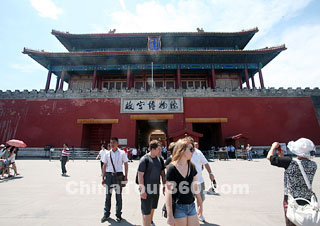 |
| Gate of Divine Prowess, Forbidden City |
The northern gate of the Forbidden City faces Jingshan Hill and is called Shenwumen, the 'Gate of Divine Prowess'. Previously, during the Ming Dynasty (1368 - 1644), it was named Xuanwu Gate. This was in accordance with the principles of Fengshui that recoginized a god for each of the cardinal points of the compass. These gods were Azure Dragon, in the east; White Tiger, in the west; Vermilion Bird in the south and Xuanwu (Murky Warrior) in the north. During the reign of Qing Emperor Kangxi, the name was considered taboo due to its similarity to the emperor’s personal name ‘Xuanye’. So, out of respect, the gate became known as 'Shenwumen’.
Situated to the north of the palace, it was an important access to the Forbidden City. It was specially for the emperor’s concubines and other members of the royal family. The empresses of the Ming and the Qing dynasties always exited from this gate to hold the Silkworm Feeding Ceremony. When the emperor left the palace for an inspection visit, he could go through the Meridian Gate (Wumen), while his entourage had to leave through the Gate of Divine Prowess. When the emperor accompanied the empress dowager, they would go out together through the Gate of Divine Prowess.
During the Qing Dynasty (1644 - 1911), the emperors usually entered the palace by the Gate of Divine Prowess after a trip to the Old Summer Palace and Rehe (the bordering area of present Hebei and Liaoning provinces as well as Inner Mongolia Autonomous Region). The candidates for the triennial Preparative Concubine Choosing also entered the palace through this entrance. In 1924, Emperor Puyi was just expelled from the palace from it.
The Gate of Divine Prowess is rectangular with 31 meters (101.7 feet) in height, having three doors. It is situated on a Xumi Base (the pedestal or base of a Buddhist tower, or temple) of white jade. A tower was built on the top of the gate, covered with yellow glazed tiles. There is a bell and a drum housed in the tower. In ancient China, the bell here would be struck 108 times at dusk. Then, the bell and the drum would be beaten once every two hours to tell the time from 19:00 to 05:00. At dawn, the bell will be struck again. When the emperor was in the palace, only the drum would be beaten.
In the Ming Dynasty, there was a market set up at the Gate of Divine Prowess on every 4th, 14th and 24th day of a month. At that time, the street in front of it were filled with various rare treasures, including bronze articles, porcelain vassals, enamels and daily utensils.
In 1925, when the Palace Museum was established, the Gate of Divine Prowess became the main entrance, with the horizontal board stating ‘Palace Museum’ hung above it.








